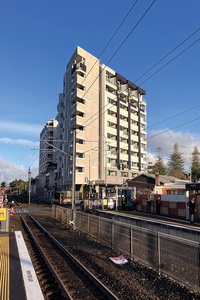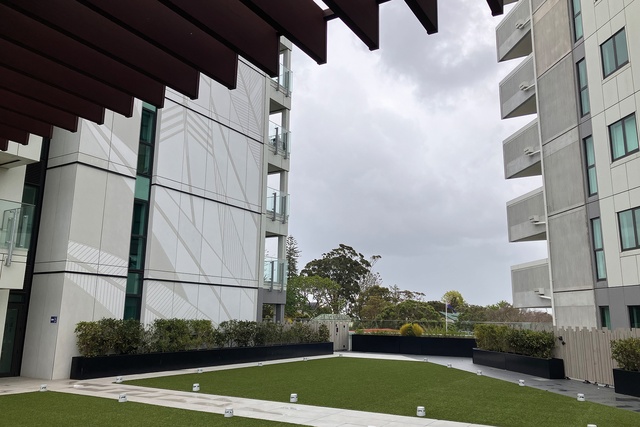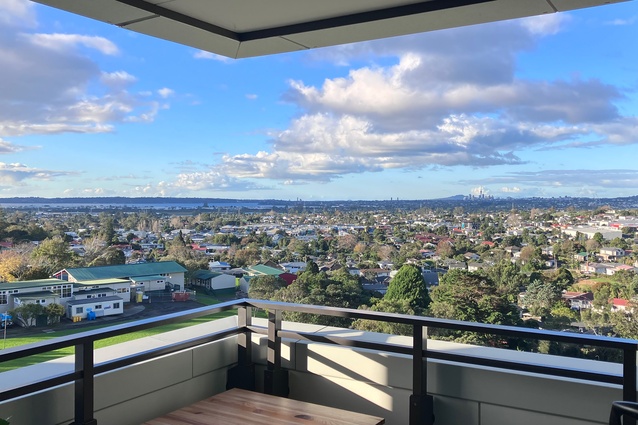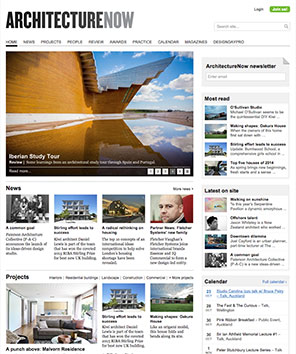Mixed tenure dwelling in the Westlight
In late 2020, the Westlight Apartments in Glen Eden were finished. The building complex comprises of two blocks, one of 10, the other of 11 storeys high, which sit on a shared parking garage of three levels. The podium that is thus created offers a communal ‘green’ space.

Brand new, they are nevertheless situated at an historically significant location: directly between Waikumete Cemetery and the train line to Swanson (that used to continue further out to Helensville). The cemetery, which opened in 1886 on land of Kawerau ā Maki, became New Zealand’s largest cemetery. Waikumete literally means “Water of the Wooden Bowl”. Curiously, the location of the cemetery was determined by the train station — and not the other way around.1
Apart from the location, the Westlight Apartments fascinate for a variety of reasons. They were initiated and financed by the Ted Manson Foundation — a charitable foundation set up by Auckland property investor Ted Manson — and they present themselves as a mixed-ownership model. Designed by mc2 Architects from Auckland, the complex comprises 165 one-or-two-bedroom apartments, 90 of which are dedicated for social housing, administered by Home in Place (a not-for-profit, regulated community housing provider). The other 75 apartments are privately owned (owner-occupied or rented).
In early 2018, while the Westlight Apartments were under construction, New Zealand Herald writer Anne Gibson quoted Ted Manson saying: “I used to think ‘if I can come up from a state house, anyone can’ but as you get older, you start to realise life is not fair. Not everyone can do it.”2 For the last 10 years, the Ted Manson Foundation has funded initiatives in the areas of education, sports programmes and well-being, but developing the Westlight Apartments is Manson’s largest social undertaking. This mix between social housing and ownership is a brave idea and seems to work reasonably well.
The building is, largely, very well designed. It looks interesting, dramatic even. Block 6, parallel to Glenview Road, sits at a 65-degree angle to both railway line and Waikumete Road. Making use of this angle, the architects have let the corner balconies angle out sculpturally, forming expressive triangles of textured concrete. Repetition in the façade is broken up through slight variation of colours, patterns and even balcony balustrade materials, which vary between aluminium panelling and glass.
Between decent materials, well-organised floor plans and a light colour palette, the building provides the dweller with everything expected, and a little more. The apartments are equipped with double glazing, insulation that makes heating nearly superfluous and with mechanical ventilation; the building is designed for a Homestar 6 rating. Also, it provides at least one balcony per apartment and, from the higher situated apartments, a truly phenomenal view over much of Auckland.

Interestingly for this type of building, few apartments are exactly the same. Like the façade, they all appear to have their own small differences. One small downside is that there are still a number of two-bedroom apartments with one internal bedroom. In many other places around the world, these are not permitted. Luckily, there are corner apartments that provide natural light and ventilation for both bedrooms.
The building’s proximity to the railway line means that catching a train to the city has been made exceptionally easy — less than a minute from the front door of Block 6 onto the platform. Equally, Glen Eden’s town centre is just a stone’s throw away.
The communal outdoor space on the second floor, between the two blocks (on top of the multilevel car park), appears a good idea, even if it does not seem to be used a lot. Interesting, but also a little odd, are the ‘terraced houses’ that bound this communal space. One keeps thinking of Jane Jacobs’ ‘eyes on the street’ — and this concept is applied here. Where the ‘terraced houses’ work very well is on Waikumete Road, as part of Block 8. Here, they allow pedestrians to experience a direct connection with the building. The high-rise does not soar above the passerby right at the footpath; instead, these units mediate the shift from the street to the high-rise. Around the corner, on Glenview Road, shops have been envisaged on the ground floor. Although these are currently unoccupied, one hopes that this great opportunity to enliven the streetscape further will soon be made use of.
How does it feel to live in this building? For the author, who has been living here for the last one and a half years, the shortest answer is: “very comfortable”. The Westlight Apartments present themselves as an unexpected addition to the smaller scale of Glen Eden, one that says “I am urban” in a serious but welcoming manner.











